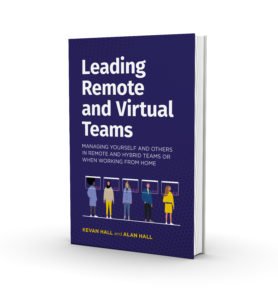How big should virtual teams be?
Participants on our remote and virtual teams training often ask how big should virtual teams be for maximum effectiveness.
At one level the answer to team size is “as big as it needs to be to deliver its purpose”. If you have a complex global team on a major project then you may need 20 or (many) more people. But we also know that the right team size size for a team in terms of effective human dynamics, decision making and maintenance of relationships is much smaller than that.
- Studies in business schools have found that an effective face to face syndicate team size is no more than 4-6 people.
- A recent Times article found that a group of 8 was the worst number of people for making decisions and that voting rather than consensus was essential for groups of 20 or more.
Both of these studies focused on the right team size for face to face groups.
In our book Speed Lead we identify two factors that drive down effective team size in complex organizations
- Interdependence – if we really need to communicate and coordinate intensively (true or what we call “spaghetti” team work) then we can only maintain a limited number of connections. (a team size of 6 people creates 15 interconnections, 20 people create 190 interconnections). Star group (hub and spoke) structures can be organized to work well with larger numbers of people
- working through technology – conference calls and other technologies limit effective contribution and discussion. If you ever attended a conference calls of 20 people you will know it soon descends into a series of monologues.
Because of this we recommend an effective team size of 4-6 for real spaghetti teamwork. If you need 20 people for a global team or project try to cluster them into several smaller sub-teams based on common objectives, geography, interdependence etc…
The average team size from our speed survey is 12 and people tell us they are part of 5 teams. This means that people are managing an average of 330 interdependent relationships. This would allow abut 7 minutes per week per relationship!
This reinforces our view that most “teams” are not really engaged in interdependent spaghetti team work but are actually groups of individuals engaged in largely independent tasks with a small amount of teamwork.
Read our book – Leading remote and virtual teams: Managing yourself and others in remote and hybrid teams or when working from home


Explore our training programs to see how we can help.
Agile & Digital Training Matrix Management Training People and purpose Training Virtual Teams TrainingEducate yourself further with a few more or our online insights:
30 years of experience learning with a range of world class clients
We work with a wide range of clients from global multinationals to recent start-ups. Our audiences span all levels, from CEOs to operational teams around the world. Our tools and programs have been developed for diverse and demanding audiences.

Tailored training or off the shelf modules for your people development needs
We are deep content experts in remote, virtual and hybrid working, matrix management and agile & digital leadership. We are highly flexible in how we deliver our content and ideas. We can tailor content closely to your specific needs or deliver off the shelf bite sized modules based on our existing IP and 30 years of training experience.
For more about how we deliver our keynotes, workshops, live web seminars and online learning.